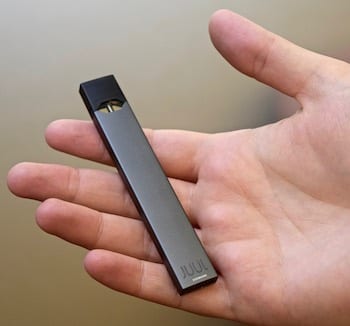
Juul e-cigarette
The earliest electronic cigarettes (e-cigarettes) looked like a metal cigarette, containing a battery and a small cartridge of solution (commonly containing nicotine), and produced a vapor that the user inhaled. Later versions grew in size to “tank” systems with larger batteries, a longer life between charges, and a larger reservoir for solution. With the advent of tank systems, hundreds of flavors and a range of nicotine strengths became available, with the common terminology changing from “e-cigarette” to “vaping devices” or “vape pens.”
The latest vaping device, under the Juul brand, looks like a sleek USB flash drive. (While there are other products mimicking Juul, this brand is popular enough with high school students that “Juuling” is a new way to refer to “vaping.”)
The Juul-type device uses a pod for the nicotine solution, available in mango, mint, fruit, tobacco and crème brulee flavors. According to Juul’s website, a pod contains “5 percent nicotine by weight,” and each pod is “approximately equivalent to 1 pack of cigarettes, or 200 puffs.” Starter kits come with a USB charger and a four-pack of pods.
The Juul-type device is drawing attention because its small size and innocuous appearance make it easy to use in school – even in the classroom. Teachers and administrators can easily mistake the device for an authentic computer accessory.
Concerns about teen use of any type of e-cigarette are two-fold. Nicotine addiction can adversely alter developing teenage brains, and some student users will move on to using traditional tobacco products.
A study published in the December 2017 issue of the journal Pediatrics, “Trajectories of E-Cigarette and Conventional Cigarette Use Among Youth,” finds evidence that teen vapers are more likely to start using traditional tobacco than students who don’t vape.
Massachusetts data show historic lows for the use of traditional tobacco products among high school students, with 15.9 percent reporting use in 2016 (7.7 percent for cigarettes, 10.4 percent for cigars, and 5.5 percent for smokeless tobacco). The statewide use of vape products among high schoolers, however, has risen to 23.7 percent.
Recent data for middle school students can be found from surveys conducted in schools in a number of municipalities just north of Boston (Arlington, Burlington, Melrose, Stoneham, Wakefield, Woburn and Winchester). In the spring of 2017, 8.9 percent of these middle school students indicated that they had tried a vaping device, while 5.4 percent report currently using one.
In addition to concerns about nicotine addiction and in-school use of vaping products, some vaping devices, especially tank systems that are filled by the user, may be used to “vape” THC (tetrahydrocannabinol), the active ingredient in marijuana.
Schools are advised to expand their no-smoking policies to including vaping devices and to inform parents about the new nicotine-delivery products available on the market.
It is also considered a best practice for municipal tobacco sales policies to cover vape devices. There are 218 municipalities that treat the sale of vaping products the same as traditional tobacco products, and 130 cities and towns have banned vaping in smoke-free locations.
A sample school policy is available from D.J. Wilson at the MMA at djwilson@mma.org.
